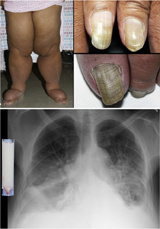Yellow Nail Syndrome

A rare, syndromic nail anomaly disease characterized by the variable triad of characteristic yellow nails, chronic respiratory manifestations, and primary lymphedema.
Epidemiology
Prevalence and incidence rates are not known, but Yellow nail syndrome (YNS) is considered a rare condition. To date, approximately 400 cases have been reported, mainly as single case reports. The disorder affects males and females equally.
Clinical description
Most cases of YNS are of late onset, after 50 years of age, but the disease has also occasionally been observed in neonates and children. Patients generally complain of slowed or arrested nail growth: the nails become thickened and opaque, with yellowish or green discoloration. The cuticles are absent and the proximal nail fold swollen. Increased transverse curvature is another feature, which may lead to nail plate shedding. Both fingernails and toenails are affected, but severity may vary. Only 1/3 of the patients with nail changes have associated lymphedema and respiratory tract involvement. Nail changes may precede the development of lymphedema or respiratory manifestations by years. Lymphedema is the most consistent associated finding and usually affects the lower limbs. Respiratory conditions include cough, bronchitis, tracheobronchitis, bronchiectasis, chronic sinusitis, chronic respiratory infections, and pleural effusions. YNS may exceptionally be a paraneoplastic disorder (lung cancer).
Etiology
The etiology of YNS has not been elucidated. Impaired lymphatic drainage not due to anatomical abnormalities, but rather to a functional disorder, appears to have a central role.
Diagnostic methods
Nail changes in YNS are pathognomonic and the presence of typical nail alterations is an absolute requirement for the diagnosis. This is because the three main signs (i.e. nail changes, respiratory disorders, and lymphedema) may not be present all at once in the patient.
Differential diagnosis
The most important nail differential diagnoses include chronic paronychia, which shares absence of the cuticle and nail thickening and discoloration, and onychomycosis of the toenails, which produces thickening and onycholysis. Onychogryphosis and acquired pachyonychia should also be considered.
Management and treatment
Spontaneous improvement in nail signs is reported in up to 30% of cases. Oral α‐tocopherol (vitamin E) at high doses, 600 to 1200 international units (IU) daily has been reported to be effective in about half of patients.
Prognosis
Some patients recover fully, but the respiratory condition and the associated symptoms are often chronic. Serious lymphedema and respiratory complications may affect quality of life and periodic follow-up is mandatory. Patients with YNS present several comorbidities other than the respiratory ones, possibly due to their older age, therefore they tipically have a lower life expectancy when compared to the general population.